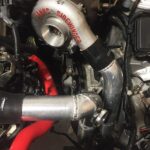Understanding and manipulating the wastegate duty cycle is a crucial aspect of car tuning, especially for turbocharged vehicles. This article delves into the intricacies of wastegate duty cycle tuning, examining its impact on boost pressure, performance, and overall engine behavior. We’ll explore key tables and factors involved in optimizing this critical parameter for both power and efficiency.
Wastegate Duty Cycle: The Basics
The wastegate is a valve that controls the flow of exhaust gases that spin the turbine in a turbocharger. By regulating this flow, the wastegate manages boost pressure. The wastegate duty cycle refers to the percentage of time the wastegate valve is closed, allowing exhaust gases to drive the turbine. A higher duty cycle generally results in higher boost pressure.
Key Tables in Duty Cycle Tuning
Several tables within engine management software play a vital role in wastegate duty cycle tuning. These include:
Wastegate Duty Cycle Table
This table directly controls the wastegate duty cycle based on engine speed (RPM) and load. Adjusting values in this table allows tuners to fine-tune boost pressure across different operating conditions. Smoothing out transitions between cells in this table is crucial for achieving consistent and predictable boost delivery. Aggressive values in high load, low RPM areas can result in rapid boost onset, potentially leading to wheel spin or other undesirable effects. Conversely, lower values can prioritize quicker spool and responsiveness. Examples of different setups, one with 0 in the first column similar to stock and another with adjustments, demonstrate the flexibility of this table. Having 100 in low RPM high load areas ensures full boost at wide-open throttle (WOT) for maximum performance.
Driver’s Air Load (DAL) Table
The DAL table influences the target air load requested by the driver. It interacts with the wastegate duty cycle table to determine the desired boost level. Higher numbers generally correlate with increased performance, while lower values can improve fuel efficiency. Tuning this table requires considering the driver’s typical driving style and RPM/load usage. For instance, daily driving might necessitate adjustments in the 2500-3000 RPM and 50-70% load range for optimal fuel economy. However, significant deviations from stock values can negatively impact responsiveness. Tuning this table for a larger turbo, like exceeding values of 240 in the last column, requires careful consideration.
Manifold Absolute Pressure Target (MALT) Table
This table defines the target air load the engine control unit (ECU) aims to achieve. While crucial for smaller turbochargers, its impact diminishes with larger, later-spooling turbos. Experienced tuners often find that manipulating other tables, like the DAL and Wastegate Duty Cycle tables, provides sufficient control over boost, rendering extensive MALT adjustments unnecessary. Using 100% across the entire table is a common practice.
Pressure RPM Factor Table
This table sets a boost limit based on barometric pressure. Each cell value is multiplied by the barometric pressure to determine the maximum allowable boost. Setting high values (e.g., 6 in every cell) effectively disables this limit, ensuring the table doesn’t restrict desired boost levels.
Factors Influencing Duty Cycle Tuning
Beyond these tables, factors like driving style significantly impact optimal duty cycle settings. Aggressive driving requires different tuning compared to more conservative styles. Individual preferences regarding throttle response, smoothness, and fuel economy further necessitate customized adjustments.
Conclusion
Duty Cycle Car Tuning offers a powerful means of optimizing turbocharged engine performance. By carefully manipulating the wastegate duty cycle table and related parameters, tuners can unlock significant gains in power, responsiveness, and efficiency. However, it’s crucial to understand the interplay between these tables and factors like driving style to achieve desired results. A holistic approach, considering all variables, is essential for successful duty cycle tuning.

